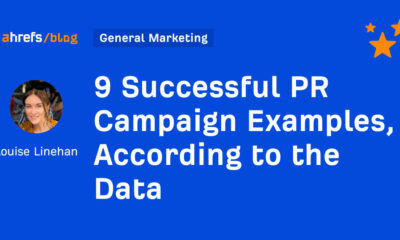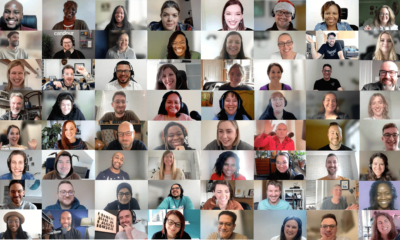SEO
13 Key Elements Of Successful YouTube Videos

YouTube is great for marketing, a fact that is supported by a ton of mind-blowing usage statistics.
These are some that really stand out:
- 500 hours of video is uploaded to YouTube every minute.
- YouTube is the second most popular social networking site, with more than 2 billion monthly users. That’s one-third of the internet!
- Viewers are 4x more likely to use YouTube vs. another platform to discover information about a brand, product, or service – meaning that there is a ready audience for your content.
- Millennials also spend a lot of their time on YouTube. Among millennials, YouTube reaches more of the 18-34 demographic than any TV network.
How can you make the most of the YouTube opportunity?
It starts with a great video. Check out these 13 key components of a successful YouTube video.
1. Branded Intro Footage
The importance of branding in marketing can never be overemphasized. Branding helps build loyalty.
Including branded intro footage helps your loyal viewers to immediately recognize your work so they’ll stick with you and keep watching.
Additionally, such branding is important for ensuring that your viewers remember the video, which is especially handy when they need to refer someone to it.
Even though they might forget the actual content and the name of the video, remembering your branded footage will help direct viewers to your channel.
2. An Attention-Grabbing Intro
Did you know that about 20% of people will leave after the first 10 seconds of your YouTube video?
What’s even worse is that they might give you a thumbs down.
So, what do you do?
It is all about the intro.
After including your branded intro footage, convince the viewer to keep watching. Clearly explain what they are about to see, and how that is of benefit to them.
If you’re showing them how to solve a problem, personalize it so that they feel that you have also been affected. This builds trust, and the feeling that the solution is valuable.
3. Keep Titles And Opening Credits Short
As mentioned above, our attention spans are incredibly short. Nothing is worse than an extensive beginning to a video that drives lost interest.
Even worse, that long opener will discourage binge-watching. Who wants to watch that same long opener over and over again?
Over half of YouTube viewers will watch the entire video when it’s under one minute in length.
Instead, strive for a ~5-second opener that is punchy and straight to the point.
4. Build Trending Topics Into Your Video Content
Using trending topics is a tried and true method for successful link building and can also be applied to your video content.
Think seasonal, newsworthy, local, unique, movies, gaming, music, or even surprising topics, etc. These are all great fodder for trending topics to bake into your videos.
Not sure where to start? Give YouTube Trending (country-specific) or Popular on YouTube (global) a try.
Google Trends and even Twitter Trends are also great resources to discover trending topics to tie into your video content.
5. Background Music
Should you include background music? After all, people are only interested in what you’re saying.
However, thanks to technology, we get bored. Fast.
There’s nothing more boring than a dull YouTube video.
Including background music not only grabs attention instantly but sets the mood for the viewing session, establishing an emotional connection.
In addition, music drives the pace of the video, while a great soundtrack only gives viewers one more reason to share the video.
However, be careful of two things:
- That the music evokes the desired emotions and aura.
- That you are legally allowed to use the music in your video.
6. Being Clearly Audible
Unfortunately, a great intro and nice background music can’t help if you aren’t clearly audible.
Remember, the ultimate goal is for your audience to understand what you are putting across. If your video is just a pictorial illustration, then loud background music suffices.
On the other hand, if your video includes an oral presentation, make sure you can be heard above the background music.
7. Brevity
Well, maybe not that short. Still, that video has more than 11 million views.
With YouTube allowing users to search for videos based on duration, among other filters, we clearly can’t ignore the importance of video length in YouTube.
8. Customized Experiences
Tap into micro-moments. These are the times when people need to know, go, do, or buy something and turn to the closest device to help them achieve it.
Use data to give people what they want, when they want it.
This can take many forms. Consider establishing a connection between events on TV or the excitement around big moments in pop culture, politics, sports, tech, and more.
Another option is to leverage data to deliver personalized video content.
To get started with this process:
- Visit Google Trends to help validate the increasing demand or topic.
- Learn what people are searching for and tailor your videos to fit into existing conversations. A keyword research tool can help you narrow in on the right keyword targets.
- Next, this free Chrome plugin from vidIQ will provide you with valuable competitive data for current ads that are going viral, including tags, social shares, average watch time, velocity, and more.
- Lastly, once the video is created, leverage YouTube Analytics to answer “who is actually watching” and “what they are truly interested in.”
9. A Call To Action
As mentioned earlier, YouTube viewers are short on time. After all, there is too much content to view in one day. They have jobs and lives (presumably).
Consequently, you need to be creative about how you include your call to action because your audience will increasingly disappear over the course of your video.
Engagement significantly drops off between two and three minutes. This means you should not place your CTA at the end, and that is particularly true for longer videos.
Instead, consider clickable annotations in the first few seconds of the video.
Bonus Tip: If you’re looking to grow your YouTube subscriber base, add the following parameter to your url: ?sub_confirmation=1.
Here’s an example: https://www.youtube.com/user/jonleeclark?sub_confirmation=1. You’ll get a nice little popup prompting the user to subscribe.
 Screenshot taken by author, May 2021
Screenshot taken by author, May 202110: Add End Screens To Promote Your Videos, Channel, Or Website
While end screens can only be added to the last 20 seconds of a video, these useful graphics can be used to link out to everything from a website URL, YouTube channel, video playlist (such as another video in a series), or prompt a watcher to subscribe.
When creating a video, make sure you leave room, as the video ends, to add your end screen.
 How to Learn SEO Fast and Effectively, Ahrefs, May 2021
How to Learn SEO Fast and Effectively, Ahrefs, May 202111. Design Video Thumbnails YouTube Users Want To Click
Of all the items in this list, thumbnails have the greatest potential to make or break your YouTube success.
And the reason is simple.
Suggested videos tend to be the leading source of organic traffic on YouTube. In a sense, YouTube acts as an “endorser” of your content by suggesting it as something a watcher might also enjoy.
Thumbnails that drive clicks are more likely to feed the algorithm resulting in more clicks and so on.
Here are three simple best practices to keep in mind:
Don’t trick the user.
Ensure the thumbnail is relevant and delivers on the video’s title. If not, you risk having a lower watch time which will negatively impact the algorithm – the opposite of what we want.
Design thumbnails for smaller screens.
YouTube recommends 1280 x 720; however, most video consumption happens on a smaller screen.
Make sure your image will still stand out by playing with color saturation, cropping to a smaller area, or playing with the edges of the image.
Bonus Tip: Can’t decide on a thumbnail? Consider testing a handful of thumbnail options with a simple Adwords test. A small investment of $10-20/day will provide some insight into which thumbnail is generating the strongest VTR (view-through-rate).
Keep a consistent style, look, and feel.
I realize this is open-ended but some considerations for consistency include logo, common colors, shapes, consistent face, font, etc.
Over time, this consistency will increase video recognition during skimming; and, if they enjoy your content, they’ll be more likely to click. The folks over at Keywordtool.io do this well.
 How to Find YouTube Trends (Tips to Grow Your Channel), Keyword Tool, May 2021
How to Find YouTube Trends (Tips to Grow Your Channel), Keyword Tool, May 202112: Build A “Guest Slot” For Other YouTubers
Perhaps the most common example of a “guest slot” is an interview.
But no matter how your structure it, collaborating with creators who already have an audience is a great way to build your own as it provides exposure to an audience that may otherwise never hear of you.
Look for creators that are already in your niche or who service an audience with similar interests. Social Blade is a tool that can help you find channels serving similar demographics and size of channel.
Be sure to feature your guest in a positive light and prominently so they’ll be more likely to cross-promote the video.
13. Give The Audience A Chance To Participate
It might seem odd if you’re not streaming live, but soliciting your audience to participate has its advantages.
For example, asking your viewers questions directly gives you opportunities to generate and provide responses to comments – further fueling the engagement algorithm.
Viewer feedback can also provide ideas for future content and the opportunities to build content around responses through ‘fan clips’ or idea shoutouts.
The Way Forward
To improve performance on YouTube, driving more traffic to your site and more revenue for your business, apply these best practices in your video creation process.
These tried and tested YouTube video elements are sure to contribute to your own video marketing success!
More Resources:
Featured Image: Alina Rosanova/Shutterstock
All screenshots taken by author, May 2021



















You must be logged in to post a comment Login